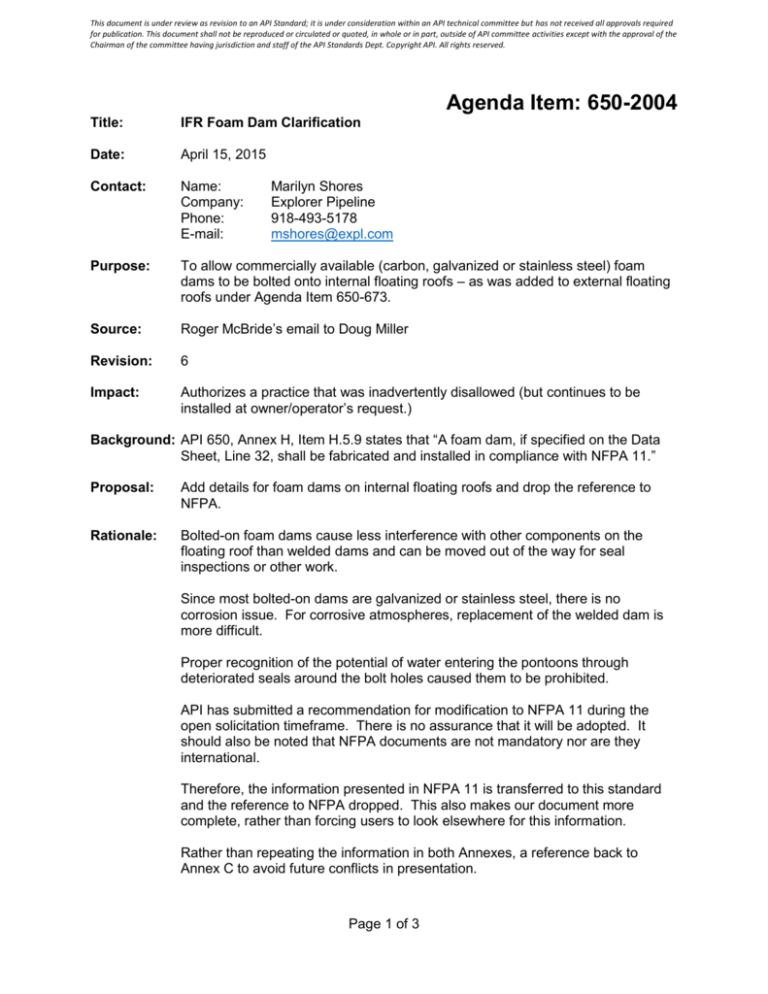
This document is under review as revision to an API Standard; it is under consideration within an API technical committee but has not received all approvals required
for publication. This document shall not be reproduced or circulated or quoted, in whole or in part, outside of API committee activities except with the approval of the
Chairman of the committee having jurisdiction and staff of the API Standards Dept. Copyright API. All rights reserved.
Agenda Item: 650-2004
Title:
IFR Foam Dam Clarification
Date:
April 15, 2015
Contact:
Name:
Company:
Phone:
E-mail:
Purpose:
To allow commercially available (carbon, galvanized or stainless steel) foam
dams to be bolted onto internal floating roofs – as was added to external floating
roofs under Agenda Item 650-673.
Source:
Roger McBride’s email to Doug Miller
Revision:
6
Impact:
Authorizes a practice that was inadvertently disallowed (but continues to be
installed at owner/operator’s request.)
Marilyn Shores
Explorer Pipeline
918-493-5178
mshores@expl.com
Background: API 650, Annex H, Item H.5.9 states that “A foam dam, if specified on the Data
Sheet, Line 32, shall be fabricated and installed in compliance with NFPA 11.”
Proposal:
Add details for foam dams on internal floating roofs and drop the reference to
NFPA.
Rationale:
Bolted-on foam dams cause less interference with other components on the
floating roof than welded dams and can be moved out of the way for seal
inspections or other work.
Since most bolted-on dams are galvanized or stainless steel, there is no
corrosion issue. For corrosive atmospheres, replacement of the welded dam is
more difficult.
Proper recognition of the potential of water entering the pontoons through
deteriorated seals around the bolt holes caused them to be prohibited.
API has submitted a recommendation for modification to NFPA 11 during the
open solicitation timeframe. There is no assurance that it will be adopted. It
should also be noted that NFPA documents are not mandatory nor are they
international.
Therefore, the information presented in NFPA 11 is transferred to this standard
and the reference to NFPA dropped. This also makes our document more
complete, rather than forcing users to look elsewhere for this information.
Rather than repeating the information in both Annexes, a reference back to
Annex C to avoid future conflicts in presentation.
Page 1 of 3
This document is under review as revision to an API Standard; it is under consideration within an API technical committee but has not received all approvals required
for publication. This document shall not be reproduced or circulated or quoted, in whole or in part, outside of API committee activities except with the approval of the
Chairman of the committee having jurisdiction and staff of the API Standards Dept. Copyright API. All rights reserved.
For reference, here is what is stated in Annex C:
(Revision 1 changes shown in turquoise.) Revision 2 was issued to address comments
submitted during balloting of Rev. 1. Revision 3 moved one sentence based on input at the Fall,
2014 meeting.
Here is how it was balloted for Spring, 2014:
H.5.9 Foam Dams
A foam dam, if specified for a full contact internal floating roof (IFR) on the Data Sheet, Line 32,
shall be fabricated and installed in compliance with NFPA 11 Paragraph C 3.16.2. The weight of
the rim fire protection system (foam dam filled with foam) shall be included with the dead weight
calculation for the buoyancy requirement per H.4.2.1.2. The following types of full contact IFR’s
are eligible for seal area foam protection systems, complete with foam dams:
Metallic pontoon (type H.2.2.c)
Metallic double-deck (type H.2.2.d)
Full liquid surface contact, metallic sandwich panel (type H.2.2.f)
All other IFR types shall require full surface foam protection when foam systems are specified.
Page 2 of 3
This document is under review as revision to an API Standard; it is under consideration within an API technical committee but has not received all approvals required
for publication. This document shall not be reproduced or circulated or quoted, in whole or in part, outside of API committee activities except with the approval of the
Chairman of the committee having jurisdiction and staff of the API Standards Dept. Copyright API. All rights reserved.
Here is a version that incorporates comments from the negative ballots (and clears it up a little
better):
H.5.9 Foam Dams
Foam dams (Data Sheet, Line 32) shall be fabricated and installed in compliance with
Paragraph C 3.16.2, except that slots to drain rainwater are not mandatory. The weight of the
rim fire protection system (foam dam filled to the top of the foam dam, including the area
between the primary and secondary seals) shall be included with the dead weight calculation
for the buoyancy requirement per H.4.2.1.2. Only metallic, full liquid surface contact, internal
floating roofs with closed compartments for buoyancy and perimeter foam dams are eligible
for seal area foam protection systems. All other internal floating roof types shall require full
surface foam protection when foam systems are specified.
Page 3 of 3








